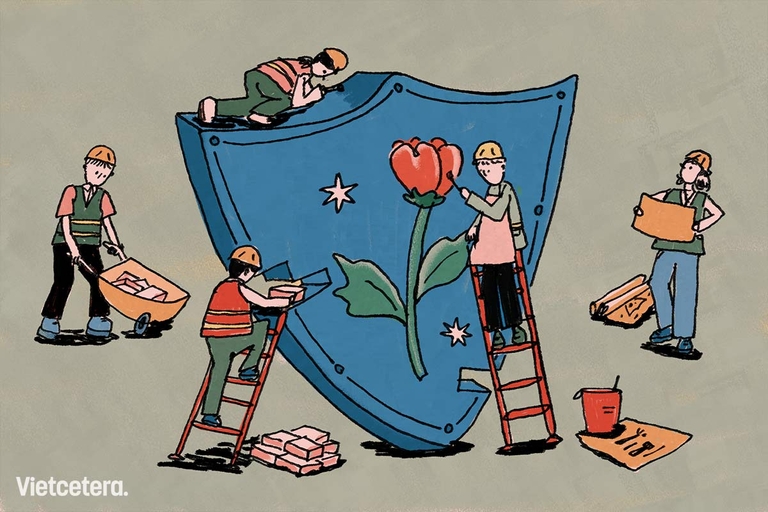After the incident involving Chau Bui, a Vietnamese fashion influencer who discovered a hidden camera in a fitting room, many women on social media shared their experiences and tips on avoiding being secretly filmed, along with apps that detect hidden cameras. This incident highlights a significant issue: women are constantly seeking ways to protect themselves.
Many products and services aimed at helping women defend themselves have surged in popularity, especially after such unfortunate incidents.
Globally, the self-defense market is expanding and making significant economic contributions. From pepper spray and stun guns to self-defense keychains and personal security consulting services, the self-defense industry has become an integral part of modern life, particularly for women.
By 2024, approximately 46% of women worldwide reported feeling unsafe walking alone at night in their neighborhoods. The global self-defense market is estimated to be worth around $3 billion in 2024, with expected growth reaching $4.55 billion by 2030.
However, behind this growth and the popularity of self-defense products for women lie critical questions about their effectiveness in addressing gender violence and inequality. Can knowing how to defend oneself eliminate gender-based violence? Can women really protect themselves from gender inequality?
Fear for sale: How self-defense products exploit anxiety
“Equipping, Empowering, Educating” is the slogan of the well-known American women’s self-defense brand, Damsel in Defense. Campaigns and media products from companies in this industry often use the motif of female empowerment, emphasizing the confidence and safety these products purportedly provide.
While the positive impact of these products cannot be entirely dismissed, it is essential to question whether women are actually empowered to control the risks they face.
These messages can unintentionally create social pressure for women to be responsible for their own safety. With various SELF-defense tools at their disposal, if an unwanted situation occurs, the blame may be placed on the victim's perceived weakness or passivity.
Moreover, advertisements often highlight the dangers lurking in the environment. Brands like Mace, Go Guarded, and Defense Divas frequently share real stories of women being harassed or assaulted in public spaces. These repeated messages can make women feel perpetually threatened, leading to heightened anxiety.

From a communications perspective, this can result in unhealthy business practices, where fear is exploited to boost sales. Emphasizing environmental dangers can increase unnecessary anxiety in women and parents of daughters.
Additionally, the idea that women must be on constant guard, especially against men, can reinforce stereotypes of men as predators, further entrenching gender divisions.
Supply Met, Demand Maintained?
Self-defense products and services are temporary solutions to the fear of violence and harassment. However, even when the supply is met with numerous tools, the demand – women's fear – remains. Will women's fear disappear?
Violence and harassment are the result of long-standing gender inequality and misogyny. Traditional views portray men as strong and dominant while women are weak and submissive.
Women also internalize these views, fearing societal judgment and often staying silent about their experiences. This creates a vicious cycle, where gender-based violence and harassment are easily accepted or ignored.
The imbalance of power and rights, rooted in prejudices about women's roles and abilities, results in their economic and social dependence on men.
This scenario leaves women powerless to protect themselves or leave abusive relationships. Limited representation in leadership and decision-making positions further marginalizes women, reducing their influence on policies and protection measures. Coupled with physical strength disparities, women are often vulnerable to becoming victims.
While the self-defense industry offers some safety benefits, it is not a long-term solution. Over-reliance on these products diverts attention from the community's and society's responsibility to create a safe environment for women.
The root causes of the problem are obscured, hindering investment in crucial preventive measures such as education on gender equality and violence, psychological and financial support for victims, and advocacy for legal and policy changes.
Predators continually devise more sophisticated methods, and new self-defense devices will emerge in response. However, without addressing the root causes, society will perpetuate an endless cycle of violence and harassment.
Self-defense in Vietnam: Is it really effective or just a mirage?
Vietnam tops the global survey with 91% of women in major cities feeling safe when going out alone at night. However, a 2015 study shows that 87% of women and girls in Hanoi and Ho Chi Minh City have been sexually harassed in public. Are public spaces in Vietnam safe, or are people not vigilant enough?
Compared to other countries, self-defense products in Vietnam have not gained much attention, and the options available are limited. Tools like pepper spray and stun guns, considered effective for self-defense, are not legally available for civilian use. The remaining options are often of low quality, lack diversity, and are difficult to access. Self-defense courses seem to be the most effective and popular solution currently.
Discussions about women's safety often focus on minimizing risk and damage (sharing locations with relatives, pretending to call someone when walking home alone, avoiding deserted roads, not provoking potential attackers when unable to fight back).

In short, the self-defense industry is not only a commercial phenomenon but also a part of the expression of an important manifestation of the long-standing struggle for gender equality. It reflects the inequalities and dangers that women face, and also the feeble efforts of women to protect themselves.
Do the producers and systems that support this sector really think about tackling gender-based violence? Do self-defense goods perpetuate the idea that women should not overreact to men' nasty jokes, just as household appliances are continuously evolving with the concept of helping women do better housework?
We must go beyond teaching women to fight back when attacked and focus on creating a society where they do not need to defend themselves in the first place.
Translated by Thúy An
